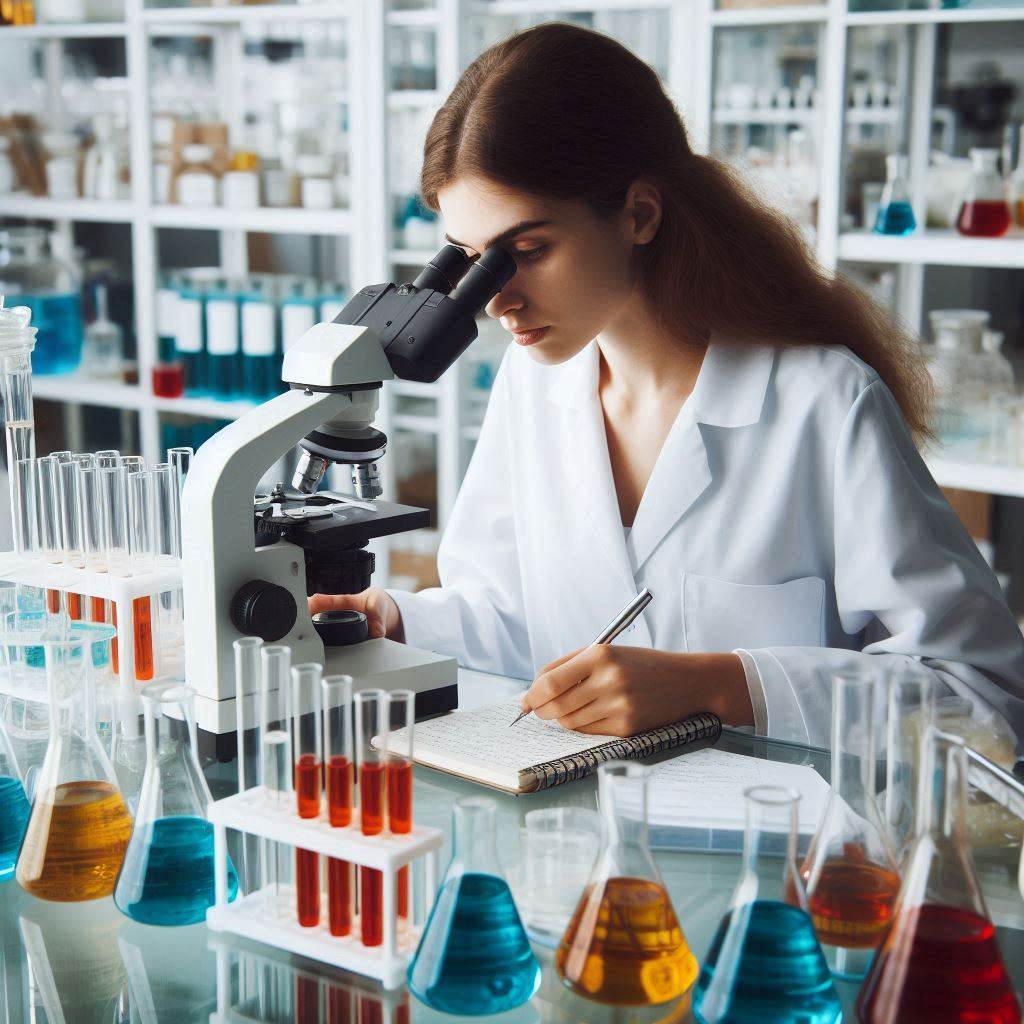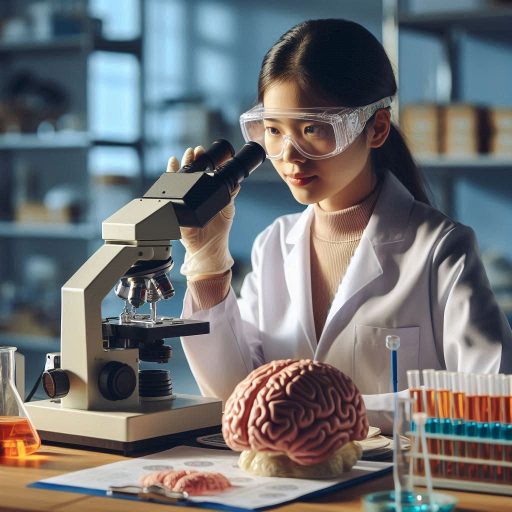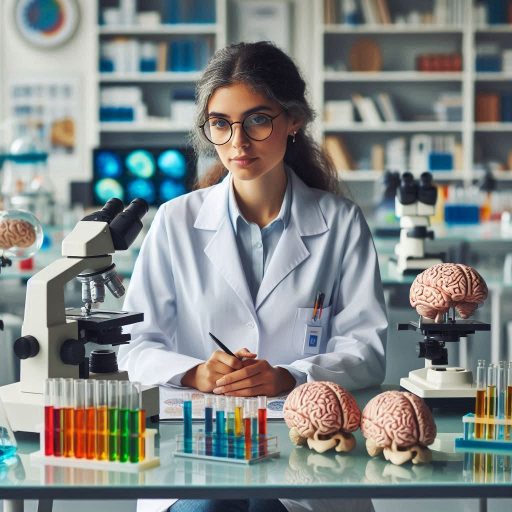Introduction
Microbiologists and biotechnologists play vital roles in science and technology.
Both professions focus on living organisms, but their goals and methods differ significantly.
Microbiologists study microorganisms like bacteria, viruses, and fungi.
They explore how these organisms affect health, the environment, and industries.
Their research helps develop treatments for diseases and improve food safety.
Biotechnologists apply biological knowledge to create innovative products and technologies.
They often manipulate genes and organisms to enhance traits for medical and agricultural purposes.
Their work leads to breakthroughs in pharmaceuticals, biofuels, and genetically modified crops.
Understanding the key differences between microbiologists and biotechnologists is essential.
This knowledge helps students and professionals choose the right career path.
It also aids employers in identifying the right talent for specific projects.
By recognizing their distinct focuses and responsibilities, we can appreciate the contributions of both professions.
Each plays a critical role in addressing global challenges, from health issues to sustainable development.
This overview sets the stage for a deeper exploration of their differences and unique contributions.
Education and Training
When considering a career as a microbiologist or a biotechnologist, education and training are crucial.
Each profession has distinct requirements that shape the educational paths of aspiring professionals.
Requirements for Becoming a Microbiologist
To become a microbiologist, individuals typically need a bachelor‘s degree in microbiology or a related field.
This degree covers essential topics like microbiology, chemistry, and biology.
Courses often include laboratory work to build practical skills.
Many microbiologists pursue a master’s degree or Ph.D. for advanced positions.
A master’s program usually takes two years and involves more specialized coursework and research.
A Ph.D. can take four to six years, focusing heavily on original research and dissertation work.
Licensure may be required for certain roles, especially in clinical microbiology.
The American Society for Microbiology offers certification to demonstrate competency.
This certification can enhance job prospects and professional credibility.
Requirements for Becoming a Biotechnologist
In contrast, aspiring biotechnologists often start with a bachelor’s degree in biotechnology, biology, or a related field.
Similar to microbiology, this degree includes coursework in molecular biology, genetics, and biochemistry.
Hands-on laboratory experience is also critical for developing practical skills.
Many biotechnologists continue their education by earning a master’s degree or Ph.D.
A master’s program typically focuses on applied research and practical applications in biotechnology.
It usually takes about two years to complete.
A Ph.D. in biotechnology requires in-depth research and can take an additional four to six years.
This degree allows individuals to work in research and development, leading innovative projects.
While certification isn‘t universally required, professional organizations like the Biotechnology Innovation Organization offer certifications that can enhance credibility.
Contrasting Educational Paths
The educational paths for microbiologists and biotechnologists show clear differences.
Microbiologists often focus more on general microbiology, including the study of bacteria, viruses, and fungi.
Their education emphasizes laboratory techniques and clinical applications.
In contrast, biotechnologists delve into the practical applications of biological science.
They often study genetic engineering, molecular biology, and bioprocessing.
Their training focuses on developing new technologies and products.
The degrees required for these professions also differ.
Microbiologists may find opportunities with just a bachelor‘s degree, but advanced degrees are essential for many roles.
Biotechnologists typically need at least a bachelor‘s degree to enter the field, with many advancing to master’s or Ph.D. programs.
Both microbiologists and biotechnologists require solid educational foundations, but their paths diverge in focus and depth.
Microbiologists emphasize microbiological principles, while biotechnologists concentrate on applying biological knowledge to solve practical problems.
Understanding these differences can guide students in choosing the right career path for their interests and goals.
Read: Day in the Life: An Environmental Scientist‘s Typical Day
Job Responsibilities
Microbiologists and biotechnologists perform essential tasks in their respective fields.
Their responsibilities reflect the distinct focuses of their professions.
Understanding these roles can help individuals choose a suitable career path.
Typical Tasks Performed by Microbiologists
Microbiologists primarily study microorganisms like bacteria, viruses, fungi, and parasites.
They conduct experiments to investigate microbial growth, behavior, and characteristics.
These experiments often involve culturing and staining microorganisms to analyze their properties.
Microbiologists analyze samples from various sources, including soil, water, and clinical specimens.
They identify pathogens and study their impact on health and the environment.
Microbiologists document their findings in detailed reports.
This documentation ensures compliance with regulatory standards and contributes to scientific knowledge.
Collaboration is essential for microbiologists, as they often work in interdisciplinary teams.
They partner with other scientists, clinicians, and public health officials to address health issues.
A significant focus for many microbiologists involves studying infectious diseases.
They investigate disease transmission mechanisms and develop strategies for prevention and control.
In industrial settings, microbiologists may oversee quality control processes.
They ensure that products meet safety and quality standards before reaching consumers.
Typical Tasks Performed by Biotechnologists
Biotechnologists apply biological systems and organisms to develop innovative products and technologies.
They focus on creating biological products like vaccines, enzymes, and biofuels.
Their work often involves genetic engineering techniques to enhance product efficacy.
Biotechnologists perform genetic modifications on organisms to study gene functions and improve traits.
They conduct experiments similar to microbiologists but focus on biotechnology applications.
Biotechnologists analyze data from their experiments to draw meaningful conclusions.
They often use statistical software to interpret complex data sets accurately.
Collaborating with scientists and engineers is crucial in their work.
This teamwork fosters innovation and the development of new technologies.
Biotechnologists also ensure compliance with regulatory standards when developing products.
They understand the importance of meeting safety and ethical guidelines.
Their work often intersects with various sectors, including healthcare and agriculture.
They strive to develop sustainable solutions to pressing global challenges.
Differences in Daily Job Duties
While both professions involve conducting experiments and analyzing data, their focuses differ significantly.
Microbiologists concentrate on understanding microorganisms and their interactions.
Their tasks often include studying pathogens and developing prevention methods.
In contrast, biotechnologists focus on applying biological knowledge to create new products.
They engage in more engineering and product development tasks.
This emphasis on practical applications distinguishes their daily duties from those of microbiologists.
Another difference lies in their work environments.
Microbiologists may work in clinical laboratories, research facilities, or public health organizations.
Biotechnologists typically work in industrial settings, focusing on product development and commercialization.
Both microbiologists and biotechnologists perform research and collaborate with teams.
However, their daily job responsibilities and focuses differ significantly.
Understanding these differences helps individuals choose the right career path based on their interests and strengths.
Read: The Impact of Technology on the Chemist Profession in the US
Industries they work in
Microbiologists and biotechnologists contribute significantly to various industries, playing unique roles in advancing science and technology.
Understanding where these professionals work provides insight into their career opportunities and the impact of their work.
Industries Where Microbiologists Are Commonly Employed
Microbiologists typically find employment in several key industries.
Healthcare is one of the most prominent sectors.
In hospitals and clinical laboratories, microbiologists analyze samples to diagnose infections.
They monitor public health and ensure safety in food and water supplies.
Many microbiologists work in food safety and quality control within the food industry.
They study pathogens that can contaminate food and develop protocols to mitigate risks.
These professionals help prevent foodborne illnesses and ensure compliance with safety regulations.
Environmental microbiology is another vital area.
Microbiologists often work in environmental agencies, studying the impact of microorganisms on ecosystems.
They contribute to efforts in bioremediation, helping to develop strategies to clean up contaminated environments using microbial processes.
In research and academia, microbiologists conduct studies in universities and private laboratories.
They explore microbial functions and their applications in various fields.
These professionals also teach and mentor the next generation of scientists, contributing to the advancement of microbiology.
Industries Where Biotechnologists Are Commonly Employed
Biotechnologists work across various industries, with a strong presence in the pharmaceutical sector.
In this industry, they develop new drugs and therapies to improve health outcomes.
Biotechnologists conduct research to create biopharmaceuticals and vaccines that address global health challenges.
The agricultural industry employs many biotechnologists as well.
They work on developing genetically modified crops that enhance yield and resistance to pests and diseases.
This work plays a crucial role in food security and sustainable agriculture, making it essential for addressing global food demands.
Biotechnologists also contribute to the environmental sector, focusing on bioremediation and waste management.
They apply biotechnological solutions to clean up polluted environments.
These solutions help develop eco-friendly processes for waste disposal, minimizing environmental impact.
In industrial biotechnology, biotechnologists develop processes for producing biofuels, biodegradable plastics, and other sustainable materials.
This industry emphasizes innovation to reduce reliance on fossil fuels and protect the environment.
Diverse Range of Fields Each Profession Can Be Found In
Both microbiologists and biotechnologists have diverse career options across multiple industries.
Microbiologists work in clinical settings, food production, environmental science, and academic research.
Their expertise in understanding microorganisms allows them to tackle various health and environmental challenges.
Conversely, biotechnologists apply their knowledge to pharmaceuticals, agriculture, environmental science, and industrial processes.
Their focus on developing new technologies and products enables them to impact health, food security, and sustainability.
Microbiologists and biotechnologists are integral to numerous industries.
Microbiologists contribute primarily to healthcare, food safety, and environmental science.
In contrast, biotechnologists focus on pharmaceuticals, agriculture, and industrial biotechnology.
Understanding these industries helps aspiring professionals identify where their skills and interests align within these dynamic fields.
Read: US Chemistry Conferences and Symposiums to Attend in 2024

Research focus
Microbiologists and biotechnologists conduct research that significantly impacts various fields, including healthcare and agriculture.
Their research focuses on different aspects of biology, reflecting their unique roles and objectives.
Understanding these focuses reveals their contributions to science and society.
Focus of Microbiologists’ Research
Microbiologists primarily study microorganisms, including bacteria, viruses, fungi, and parasites.
They aim to understand the characteristics and behavior of these organisms.
Their research investigates microbial physiology, genetics, and ecology.
This helps researchers comprehend how microbes function in diverse environments.
One major area of microbiologists’ focus is infectious diseases.
They study pathogenic microorganisms to identify their transmission mechanisms and virulence factors.
This knowledge is crucial for developing effective treatments and preventive measures.
Microbiologists also study the human microbiome, which plays a vital role in health and disease.
They explore how microbial communities influence metabolic processes and immune responses.
Environmental microbiology is another significant research area.
Microbiologists study the roles of microbes in soil health, nutrient cycling, and biogeochemical processes.
They also examine how microorganisms can help remediate contaminated environments.
Understanding these processes allows microbiologists to contribute to environmental sustainability and ecosystem management.
Focus of Biotechnologists’ Research
Biotechnologists apply biological knowledge to develop innovative products and technologies.
Their research often centers around genetic engineering, molecular biology, and bioprocessing.
They aim to manipulate organisms at the genetic level to enhance desired traits or produce valuable substances.
One prominent area of biotechnological research is pharmaceutical development.
Biotechnologists create biopharmaceuticals, vaccines, and therapeutics to address health issues.
Their research involves using recombinant DNA technology to produce proteins and antibodies for medical use.
This work has led to significant advancements in treating diseases such as cancer and autoimmune disorders.
Agricultural biotechnology is another critical focus for biotechnologists.
They research genetically modified organisms (GMOs) to improve crop yield and resistance to pests and diseases.
This research plays a vital role in enhancing food security and sustainable agricultural practices.
Biotechnologists also explore industrial applications of biotechnology.
They develop processes for producing biofuels, biodegradable plastics, and other sustainable materials.
Their research focuses on optimizing fermentation processes and utilizing waste materials to create valuable products.
Specific Areas of Study Within Each Profession
Microbiologists concentrate on understanding microorganisms and their interactions.
They study microbial ecology, infectious diseases, and environmental processes.
In contrast, biotechnologists focus on applying this knowledge for practical applications.
Their work explores genetic engineering, pharmaceutical development, and agricultural biotechnology.
Both professions significantly contribute to scientific research and innovation.
Microbiologists provide insights into microbial functions and health impacts.
Biotechnologists develop new technologies and products that address global challenges.
Microbiologists and biotechnologists have distinct research focuses reflecting their unique roles in science.
Understanding these areas of study highlights the importance of each profession in advancing knowledge and technology.
Their combined efforts continue to shape our understanding of biology and its applications across various fields.
Transform Your Career Today
Unlock a personalized career strategy that drives real results. Get tailored advice and a roadmap designed just for you.
Start NowRead: Key Roles and Responsibilities of a Chemist in the US
Career Growth and Opportunities
Microbiologists and biotechnologists enjoy diverse career growth and advancement opportunities.
Their paths may differ, reflecting their unique skills and contributions.
Understanding these opportunities can help individuals navigate their career choices effectively.
Advancement Opportunities for Microbiologists
Microbiologists often begin their careers in entry-level laboratory positions or as research assistants.
As they gain experience, they can advance to roles such as laboratory managers or senior researchers.
Many microbiologists choose to specialize in areas like clinical microbiology, environmental microbiology, or food safety.
Specialization can enhance job prospects and earning potential.
Microbiologists can also pursue additional education, such as a master‘s or doctoral degree.
Advanced degrees open doors to teaching positions at universities and research institutions.
These roles allow microbiologists to mentor future scientists and lead significant research projects.
In addition to research and teaching, microbiologists may transition into regulatory or quality control positions.
They can work for government agencies, ensuring public health and safety.
This career path offers opportunities to impact policies and regulations affecting health and safety standards.
Advancement Opportunities for Biotechnologists
Biotechnologists often start their careers as laboratory technicians or research assistants in biotech companies.
With experience and demonstrated skills, they can advance to positions such as project managers or research scientists.
Biotechnologists frequently specialize in areas like genetic engineering, pharmaceuticals, or agricultural biotechnology.
Advanced education, such as a master‘s or Ph.D., significantly enhances advancement opportunities for biotechnologists.
Those with advanced degrees often secure leadership positions in research and development.
They may lead teams working on innovative products and technologies that can revolutionize industries.
Biotechnologists can also explore careers in regulatory affairs or intellectual property.
These roles involve ensuring compliance with regulations and protecting innovations through patents.
Such positions offer the potential for career growth and an opportunity to shape industry standards.
Contrasting Career Paths and Potential for Growth
While both professions offer growth opportunities, their paths differ.
Microbiologists often focus on research, public health, and quality control.
Their career growth may involve specialized research roles or positions in regulatory agencies.
Biotechnologists, on the other hand, often emphasize product development and innovation.
Their career growth can lead to leadership roles in biotech firms, focusing on cutting-edge technologies.
The demand for biotechnology solutions continues to rise, enhancing job security and growth potential.
Overall, both microbiologists and biotechnologists have promising career paths.
Each profession offers unique opportunities for advancement and specialization.
Aspiring professionals should consider their interests and strengths when choosing a path.
Understanding the differences can help them make informed decisions about their future careers.
Microbiologists and biotechnologists have diverse career growth opportunities.
Their advancement paths differ, but both fields offer significant potential for professional development.
Choosing the right path can lead to a fulfilling and impactful career.
Explore Further: Understanding the Hydrologic Cycle: Basics and Beyond
Salary and Benefits
Understanding salary and benefits is crucial for anyone considering a career in microbiology or biotechnology.
Both professions offer competitive salaries, but they can vary significantly based on factors like experience, location, and industry.
Let‘s explore the average salary ranges and benefits for both microbiologists and biotechnologists.
Average Salary Range for Microbiologists
According to the U.S. Bureau of Labor Statistics, the average salary for microbiologists is around $84,000 per year.
Entry-level positions typically pay between $50,000 and $60,000 annually.
As microbiologists gain experience and specialize in specific areas, their salaries can increase significantly.
Microbiologists with advanced degrees, such as a master‘s or Ph.D., often earn higher salaries.
Senior researchers or laboratory managers can earn $100,000 or more annually.
Microbiologists working in pharmaceutical or biotech industries generally enjoy higher salaries than those in academic or government roles.
Location also impacts salary levels.
For example, microbiologists in metropolitan areas with a high demand for their expertise often earn more.
States like California and Massachusetts offer some of the highest salaries for microbiologists due to the presence of numerous biotech firms.
Average Salary Range for Biotechnologists
Biotechnologists tend to have a similar salary range, with an average annual salary around $88,000.
Entry-level biotechnologists typically earn between $55,000 and $65,000.
As they gain experience and specialize, their earnings can rise significantly.
Biotechnologists with advanced degrees often command higher salaries.
Senior positions, such as project managers or research directors, can earn upwards of $120,000 annually.
Those working in innovative biotech firms or research institutions usually have better compensation packages.
Like microbiologists, biotechnologists’ salaries also vary by location.
Areas with a high concentration of biotech companies, such as California’s Silicon Valley, often offer higher salaries.
Biotechnologists in research-heavy regions can also benefit from competitive compensation.
Differences in Compensation and Benefits
While both professions offer competitive salaries, biotechnologists generally earn slightly more than microbiologists.
The average salary difference can be attributed to the focus on product development and innovation in biotechnology.
Additionally, biotechnologists often work in industries with higher profit margins, such as pharmaceuticals.
Benefits for both professions typically include health insurance, retirement plans, and paid time off.
Some companies also offer bonuses, stock options, and professional development opportunities.
Biotechnologists may have access to more extensive benefits, particularly in larger biotech firms.
Microbiologists and biotechnologists enjoy competitive salaries and benefits, with biotechnologists often earning slightly more.
Factors such as education, experience, and location significantly impact compensation.
Understanding these differences can help individuals make informed career decisions.
Both professions offer rewarding opportunities for personal and professional growth.
Gain More Insights: Networking Tips for Aspiring Genetic Researchers
Conclusion
Microbiologists and biotechnologists have distinct roles, responsibilities, and focuses within the life sciences.
Microbiologists study microorganisms and their effects on health and the environment.
They often work in research, healthcare, and regulatory roles.
In contrast, biotechnologists apply biological principles to develop new technologies and products.
Their work often involves genetic engineering and innovation in various industries, such as pharmaceuticals and agriculture.
Understanding these key differences is essential for anyone considering a career in either field.
Each profession requires different educational backgrounds, skill sets, and personal interests.
Choosing the right path can lead to fulfilling careers that contribute to societal advancement.
Both microbiologists and biotechnologists play critical roles in addressing global challenges, from infectious diseases to sustainable food production.
Recognizing their unique contributions allows individuals to appreciate the importance of both professions.
Ultimately, whether pursuing microbiology or biotechnology, understanding these distinctions will help aspiring professionals make informed decisions.
Each field offers rewarding opportunities for those passionate about science and its application to real-world problems.
[E-Books for Sale]
The Big Book of 500 High-Paying Jobs in America: Unlock Your Earning Potential
$19.99 • 500 High-Paying Jobs • 330 pages
Explore 500 high-paying jobs in America and learn how to boost your career, earn more, and achieve success!
See All 500 High-Paying Jobs of this E-Book
1001 Professions Without a Degree: High-Paying American Jobs You Can Start Now
$19.99 • 1001 Professions Without a Degree • 174 pages
Discover 1001 high-paying jobs without a degree! Unlock career tips, skills, and success strategies for just $19.99!




